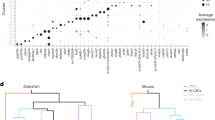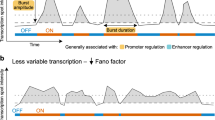Abstract
IN this report, cell cycle times were measured in the embryonic chick retina by continuous labelling with 5-bromodeoxyuridine (BUdR) and the fluorescence plus Giemsa1 (FPG) technique. The measurement of cell cycle times in embryonic chick tissues in vivo is preferably carried out by continuous rather than pulse labelling because a single injection of a nucleotide precursor into an egg can form a long-lasting pool which remains available for at least 24 h (ref. 2). Continuous labelling with BUdR provides information about the number of S phases a metaphase cell has encountered since the start of labelling whereas the previous continuous labelling procedure3 using tritiated thymidine indicates that a mitotic cell has encountered an S phase but does not show how many. BUdR labelling thus gives more detailed data for estimating the means, variances and distributions of the durations of the cell cycle and its phases. Analysis of the data by statistical modelling has shown that the cell cycle is made up of a phase of constant duration and one of variable duration and we were able to test the appropriateness of different models for the variable phase. The variable phase was described well by a gamma distribution which was clearly not exponential in form and, somewhat less well, by an inverse gaussian distribution. A random transition in the cell cycle would be indicated by an exponentially distributed period; therefore, for the random transition model4,5 of the cell cycle to hold, there would have to be an exponentially distributed component within the variable phase. Our results do not exclude this but they do show that such a component could only be a minor part of the variable phase.
This is a preview of subscription content, access via your institution
Access options
Subscribe to this journal
Receive 51 print issues and online access
$199.00 per year
only $3.90 per issue
Buy this article
- Purchase on Springer Link
- Instant access to full article PDF
Prices may be subject to local taxes which are calculated during checkout
Similar content being viewed by others
References
Perry, P. & Wolff, S. Nature 251, 156–158 (1974).
Morris, V. B. Chromosoma 60, 139–145 (1977).
Puck, T. T. & Steffen, J. Biophys. J. 3, 379–397 (1963).
Smith, J. A. & Martin, L. Proc. natn. Acad. Sci. U.S.A. 70, 1263–1267 (1973).
Shields, R. Nature 273, 755–758 (1978).
Harris, T. E. The Theory of Branching Processes (Springer, Berlin, 1963).
MacDonald, P. D. M. in The Mathematical Theory of the Dynamics of Biological Populations (eds Bartlett, M. S. & Hiorns, R. W.) 303–314 (Academic, London, 1973).
Bloom, S. E. & Hsu, T. C. Chromosoma 51, 261–267 (1975).
Cowan, R., Culpin, D. & Morris, V. B. (in preparation).
Takahashi, M. J. theor. Biol. 18, 195–209 (1968).
Signoret, J. J. Embryol. exp. Morph. 42, 5–14 (1977).
Wheals, A. E. Nature 267, 647–648 (1977).
Hughes, A. F. W. & Fell, H. B. Q. Jl microsc. Sci. 90, 37–55 (1949).
Author information
Authors and Affiliations
Rights and permissions
About this article
Cite this article
MORRIS, V., COWAN, R. & CULPIN, D. Variability of cell cycle times measured in vivo in embryonic chick retina by continuous labelling with BUdR. Nature 280, 68–71 (1979). https://doi.org/10.1038/280068a0
Received:
Accepted:
Issue Date:
DOI: https://doi.org/10.1038/280068a0
Comments
By submitting a comment you agree to abide by our Terms and Community Guidelines. If you find something abusive or that does not comply with our terms or guidelines please flag it as inappropriate.



